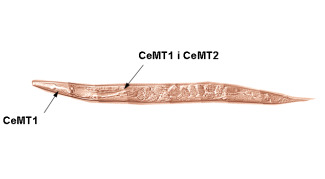The coordinating properties of metallothioneins in C. elegans

A research team made up of chemists of the UAB and biologists of the UB has studied the metallothionein system of the nematode Caenorhabditis elegans, a model organism in molecular biology. Although metallothioneins have been related to different functions in the organism, such as heavy metal detoxification, intense work is still being caried out to determine their specific functionality. The research has discovered the binding properties of the two known metallothioneins in C. elegans.
Metallothioneins (MTs) are low molecular-weight metalloproteins (60-100 amino acids) with a high cysteine content (33 %), which confer them a high metal binding capacity. Nevertheless, histidines can also contribute to metal coordination. Although MTs have been related to different functions in the organism (heavy metal detoxification, zinc and copper homeostasis, antioxidant functions, etc.) there is still an intense work to determine their specific functionality, which in turn is hampering their classification.
This work is centered on the study of the MT system of the nematode Caenorhabditis elegans, which is a model organism in Molecular Biology and Developmental Studies. This fact has drawn a special attention to C. elegans’ MT system, which consists of two different MTs, CeMT1 and CeMT2, of 75 and 63 amino acids respectively. Both proteins mainly differ in the final part of their sequences (C-terminal domain), since CeMT1 presents a segment of 15 amino acids that includes 3 histidines and a cysteine, while CeMT2 only contains a terminal histidine.
We have studied and compared the coordinative properties of CeMT1 and CeMT2 towards zinc(II), cadmium(II) and copper(I) by means of the chemical characterization of their metal-MT complexes obtained by genetic engineering. Also, the two independent domains (N-terminal and C-terminal fragments) of both MTs have been characterized, as well as a derivative mutant peptide of CeMT2 in which the terminal histidine has been suppressed (ΔHisCeMT2). Additionally, we have identified and quantified the contribution of the histidines to metal binding by means of the reaction of these amino acids with a specific reactant for histidines.
This work has demonstrated that CeMT1 employs not only its cysteines but also its histidines to bind a structural zinc(II) ion in its C-terminal domain. Additionally, through the comparative study of the binding properties of CeMT1 and CeMT2 towards the different metal ions, it has been deduced that histidines are responsible for granting to these proteins a higher affinity towards zinc than copper, a result that is in close relationship with the different physiological functions that these proteins perform inside the organism.
References
"Caenorhabditis elegans metallothionein isoform specificity - metal binding abilities and the role of histidine in CeMT1 and CeMT2". Bofill, R; Orihuela, R; Romagosa, M; Domenech, J; Atrian, S; Capdevila, M. FEBS JOURNAL, 276 (23): 7040-7056 DEC 2009.


